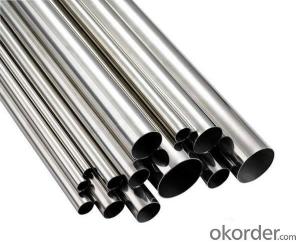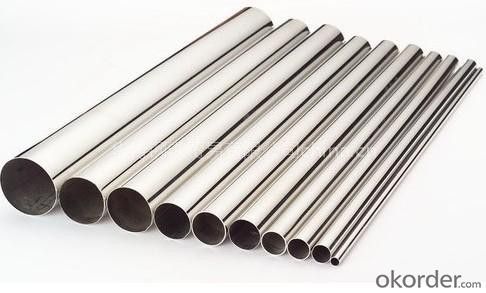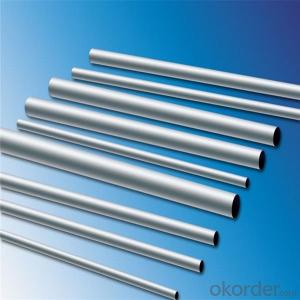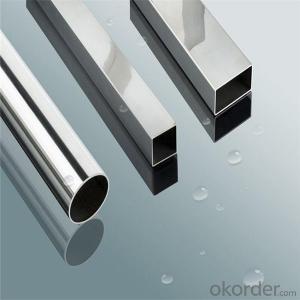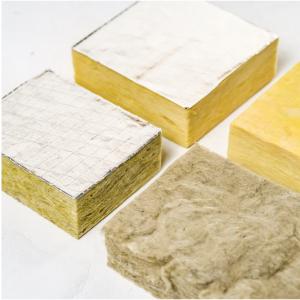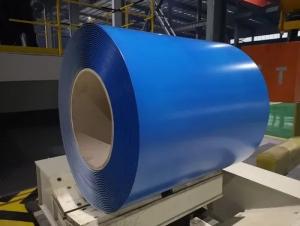Stainless Steel and Pipes Bayamon Telefono Boiler Heat Exchange Stainless Steel Pipe 2205
- Loading Port:
- Tianjin
- Payment Terms:
- TT OR LC
- Min Order Qty:
- 1 m.t.
- Supply Capability:
- 1000 m.t./month
OKorder Service Pledge
OKorder Financial Service
You Might Also Like
Product Description:
1、Structure of Boiler Heat Exchange Stainless Steel Pipe 2205 ASTM A213 Description:
Boiler Heat Exchange stainless steel pipe is often used in the heating system. Heating system, or those stored energy (such as solar energy) in the form of heat, need to be built with the material that can withstand temperatures up to 550 degrees Celsius. High chromium molybdenum welded steel pipe can work in the extreme, which maintain as the ideal material for the construction of power station.
2、Main Features of Boiler Heat Exchange Stainless Steel Pipe 2205 ASTM A213:
• High manufacturing accuracy
• High strength
• Small inertia resistance
• Strong heat dissipation ability
• Good visual effect
•Reasonable price
3、Boiler Heat Exchange Stainless Steel Pipe 2205 ASTM A213 Images:
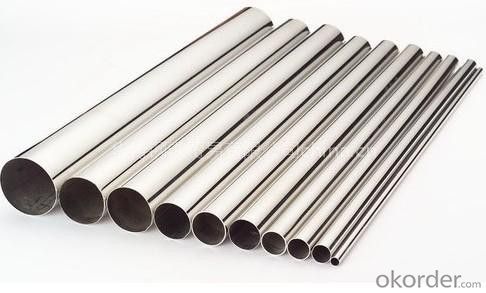
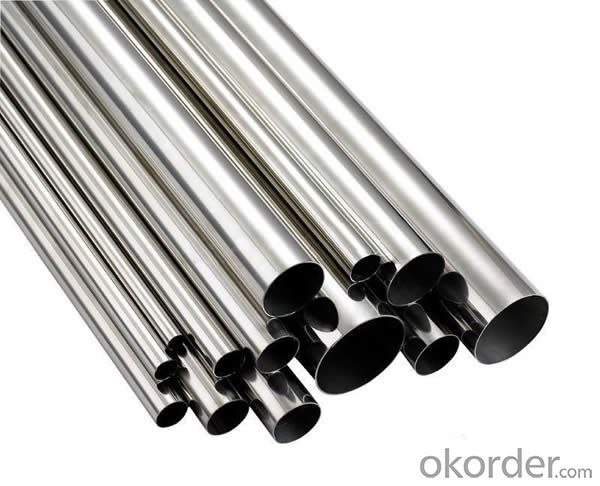

4、Boiler Heat Exchange Stainless Steel Pipe 2205 ASTM A213 Specification:
1)Commodity: heat exchanger pipe
2))Material: 304,316L,304L,316,321,310S,etc
3)Thickness:0.5-100mm
4)Length: 1-14m
| Material Grade | 304,304L,316 ,316L,321,310S,2205,904and so on. |
| Standard | ASTM A312, A554, A249, A269 and A270,ect |
| DIN 17456-85 , DIN 17458-85, DIN 17459-92,ect | |
| JIS G3446-1994, JIS G3448-1997, JIS G3459-1997, JIS G3463-1994,ect | |
| GB13296-1991, GB14975-2002, GB14976-2002,ect | |
| Outer Diameter | 13.7-2020mm |
| Thickness | 0.5-50mm |
| Length | 1m -12m or as customers' request |
| Polish | 180G, 320G, 400G Satin / Hairline |
| 400G, 500G, 600G or 800G Mirror finish | |
| Test | eddy current inspection, ultrasonic inspection, X-ray inspection, real-time imaging, hydrostatic test, spectral analysis, intergranular corrosion, water pressure test, and mechanical property testing facilities. |
| Payment | 1) by L/C at sight, |
| 2) 30% deposit, 70% balance before Shipping. | |
| Delivery time | A.7 days if this goods is stock goods. |
| B.25 days if this goods will be produced after order | |
| Validity | Valid time is 3 days for price usually. |
| Payment terms | FOB Tianjin |
| MOQ | 1 ton |
| Capacity | 1000 ton per month |
| Certificate | ISO, SGS, and third part inspection |
| Applications | the products are widely used in chemical industry, condenser pipe, heat exchanger, petroleum, shipping military, environment protection, high temperature resistant, low temperature resistant, corrosion resistant and so on. |
| packing details | 1) Wooden-box Package. 2) The Wooden Frame Packing. 3) Intertexture Cloth Packaging with the Iron Sheet Bonding and the Two Terminals Covered With Plastic Dome. |
5、FAQ of Boiler Heat Exchange Stainless Steel Pipe 2205 ASTM A213 :
①How is the quality of your products?
Our products are manufactured strictly according to national and internaional standard, and we take a test on every pipe before delivered out. If you want see our quality certifications and all kinds of testing report, please just ask us for it.
Guaranteed: If products’ quality don’t accord to discription as we give or the promise before you place order, we promise 100% refund.
②How about price?
Yes, we are factory and be able to give you lowest price below market one, and we have a policy that “ for saving time and absolutely honest business attitude, we quote as lowest as possible for any customer, and discount can be given according to quantity”,if you like bargain and factory price is not low enough as you think, just don’t waste your time.Please trust the quotation we would give you, it is professional one.
③Why should you chose us?
Chose happens because of quality, then price, We can give you both.Additionally, we can also offer professional products inquiry, products knowledge train(for agents), smooth goods delivery, exellent customer solution proposals.Our service formula: good quality+good price+good service=customer’s trust
SGS test is available, customer inspection before shipping is welcome, third party inspection is no problem.
Any question, pls feel free to contact us !
- Q:What is the difference between duplex and super duplex stainless steel pipes?
- Duplex and super duplex stainless steel pipes are both variations of stainless steel that offer enhanced corrosion resistance and superior strength compared to traditional stainless steel pipes. However, there are some key differences between the two. Duplex stainless steel pipes are made up of a mixture of austenite and ferrite phases, with around equal amounts of each. This balanced composition provides excellent resistance to stress corrosion cracking, pitting, and crevice corrosion. Duplex stainless steel pipes have a higher strength compared to austenitic stainless steels, making them suitable for applications that require higher mechanical strength. On the other hand, super duplex stainless steel pipes have an even higher content of alloying elements such as chromium, molybdenum, and nitrogen. This results in a microstructure with a higher proportion of ferrite phase, further enhancing the material's corrosion resistance and strength. Super duplex stainless steel pipes are particularly resistant to chlorides, making them ideal for applications exposed to aggressive environments such as seawater, chemical processing, and oil and gas industries. In terms of mechanical properties, super duplex stainless steel pipes typically have a higher tensile strength and yield strength compared to duplex stainless steel pipes. This increased strength allows super duplex stainless steel pipes to withstand higher pressures and temperatures. Both duplex and super duplex stainless steel pipes offer excellent corrosion resistance, but the super duplex variant provides superior resistance to a wider range of corrosive environments. However, it is important to note that super duplex stainless steel pipes are more expensive than duplex stainless steel pipes due to their higher alloy content. Ultimately, the choice between duplex and super duplex stainless steel pipes depends on the specific application requirements, such as the severity of the corrosive environment, mechanical strength needed, and budget considerations.
- Q:Can stainless steel pipes handle acidic or alkaline fluids?
- Yes, stainless steel pipes can handle both acidic and alkaline fluids. Stainless steel is known for its excellent corrosion resistance, which makes it highly suitable for handling aggressive substances. It contains chromium, which reacts with oxygen to form a thin protective layer on the surface of the steel, preventing further corrosion. This passive layer is stable in both acidic and alkaline environments, providing long-term protection against corrosive fluids. However, the corrosion resistance can vary depending on the specific grade of stainless steel used and the concentration and temperature of the fluids being transported. It is important to select the appropriate grade of stainless steel and consider factors such as temperature, concentration, and potential exposure to other corrosive substances when choosing stainless steel pipes for handling acidic or alkaline fluids.
- Q:What are the different grades of stainless steel used in pipe manufacturing?
- There are several different grades of stainless steel that are commonly used in pipe manufacturing. These grades are designated by a number system, with the most common grades being 304, 316, and 430. Grade 304 stainless steel is the most widely used and versatile grade of stainless steel. It contains a high level of chromium and nickel, which gives it excellent corrosion resistance and durability. This grade is ideal for applications where the pipe may come into contact with corrosive substances or environments, such as in chemical processing plants or marine applications. Grade 316 stainless steel is similar to grade 304, but it contains a higher level of molybdenum. This additional element enhances the grade's corrosion resistance, particularly against chlorides and other harsh chemicals. Grade 316 is often used in industries such as pharmaceuticals, food processing, and coastal areas where saltwater exposure is common. Grade 430 stainless steel is a lower-grade option compared to 304 and 316. It has a lower level of nickel and does not contain molybdenum. While it still offers good corrosion resistance in many environments, it is not as resistant to certain corrosive agents as the higher grades. Grade 430 is commonly used in applications where cost is a primary consideration, such as for exhaust systems or decorative purposes. Other grades of stainless steel, such as 201 and 409, may also be used in pipe manufacturing, depending on the specific requirements of the application. Each grade has its own unique properties and characteristics, making it important to select the appropriate grade based on the desired performance, corrosion resistance, and cost considerations.
- Q:Can stainless steel pipes be used for underground gas lines?
- Yes, stainless steel pipes can be used for underground gas lines. Stainless steel is highly resistant to corrosion and can withstand extreme temperatures, making it a suitable material for underground gas distribution systems. Additionally, stainless steel pipes have a long lifespan and require minimal maintenance, making them a reliable choice for underground gas line installations.
- Q:Can stainless steel pipes be used for drinking water applications?
- Yes, stainless steel pipes can be used for drinking water applications. Stainless steel is a corrosion-resistant material that does not leach harmful chemicals into the water, making it a safe and reliable option for transporting drinking water.
- Q:Can stainless steel pipes be insulated with silicone?
- Yes, stainless steel pipes can be insulated with silicone. Silicone is a versatile material that can withstand a wide range of temperatures, making it suitable for insulating pipes that carry hot or cold fluids. Silicone insulation is typically available in the form of sleeves or wraps that can be easily applied to the pipe surface. It provides excellent thermal insulation, preventing heat loss or gain from the pipe and improving energy efficiency. Additionally, silicone insulation is resistant to moisture, chemicals, and UV radiation, ensuring long-lasting performance.
- Q:How do you prevent leakage in stainless steel pipes?
- One way to prevent leakage in stainless steel pipes is to ensure proper installation and fitting of the pipes. This includes using high-quality gaskets, seals, and compression fittings that are compatible with stainless steel. Additionally, regular inspection and maintenance of the pipes, including checking for any signs of corrosion or damage, can help identify and address potential leak points before they become problematic.
- Q:304 stainless steel pipe, 20*2 pressure, how many kilograms?
- 304 yield strength is 210 R=, thickness D=, outer diameter, P=210/20=10.5, MPa, 1MPa=10, KG, can withstand 105 kg.
- Q:304L stainless steel pipe can withstand 0.1MPA?
- 304L stainless steel pipe can withstand 0.1MPAThe pipe can be able to withstand the pressure to see the size, there is the stainless steel seamless pipe pressure is stronger than that of stainless steel pipe joints. 0.1Mpa=10 kg pressure.
- Q:What is the working temperature range for stainless steel pipes?
- The working temperature range for stainless steel pipes depends on the specific grade of stainless steel being used. Generally, stainless steel pipes can withstand a wide range of temperatures, from extremely low temperatures to high temperatures. For austenitic stainless steel grades, which are the most commonly used in pipe applications, the working temperature range is typically from -196°C (-320°F) to 816°C (1500°F). These grades, such as 304 and 316, exhibit excellent heat resistance and can maintain their strength and corrosion resistance even at elevated temperatures. However, it is important to note that the working temperature range can vary depending on the specific alloy composition and the application requirements. Some specialized stainless steel grades, such as duplex or super duplex stainless steels, may have different temperature limits due to their unique characteristics. It is always recommended to consult the manufacturer's specifications and guidelines to determine the specific working temperature range for a particular grade of stainless steel pipe. Additionally, considering factors such as pressure, corrosive environment, and thermal cycling should also be taken into account when determining the appropriate working temperature range for stainless steel pipes.
1. Manufacturer Overview |
|
|---|---|
| Location | |
| Year Established | |
| Annual Output Value | |
| Main Markets | |
| Company Certifications | |
2. Manufacturer Certificates |
|
|---|---|
| a) Certification Name | |
| Range | |
| Reference | |
| Validity Period | |
3. Manufacturer Capability |
|
|---|---|
| a)Trade Capacity | |
| Nearest Port | |
| Export Percentage | |
| No.of Employees in Trade Department | |
| Language Spoken: | |
| b)Factory Information | |
| Factory Size: | |
| No. of Production Lines | |
| Contract Manufacturing | |
| Product Price Range | |
Send your message to us
Stainless Steel and Pipes Bayamon Telefono Boiler Heat Exchange Stainless Steel Pipe 2205
- Loading Port:
- Tianjin
- Payment Terms:
- TT OR LC
- Min Order Qty:
- 1 m.t.
- Supply Capability:
- 1000 m.t./month
Offcanvas right
OKorder Service Pledge
OKorder Financial Service
Similar products
New products
Hot products
Hot Searches
Related keywords

